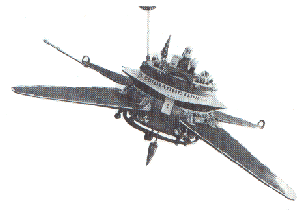|
|
Prognoz 9

Prognoz 9 was launched 1 July 1983 into a highly
eccentric orbit (apogee 720,000 km; perigee 380 km). The orbital inclination
was 65.5 degrees and the orbital period was 26.7 days. The spacecraft was spin
stabilized with a period of 113 s. The spin axis pointed towards the Sun, and
was repointed every few days.
The SIGNE II M P-9 experiment aboard the Prognoz 9 satellite operated for 8
months, after being turned on 2 July 1983. It was designed to study cosmic and
solar gamma-ray bursts in the 40-8000 keV energy range. The experiment
included 2 identical 15 cm diameter by 2 cm thick NaI (Tl) scintillators. One
faced in the solar direction, and the other faced the anti-solar direction.
Thus, 4-pi steradians were under simultaneous observation. With a surface area
of ~178 cm2, these detectors were some 3 times larger than the
previously flown SIGNE detectors. The energy resolution was 20% at 662 keV.
The output pulses from each photomultiplier were analyzed simultaneously in
11 energy channels. Background counts were accumulated over 64 s intervals. A
trigger signal was generated for the solar-pointed detector when the count rate
exceeded the background by 8-sigma over a 0.5 s interval. For the anti-solar
detector, a trigger signal was generated when the count rate in either a 0.5 s
or a 2 s interval exceeded the background by 8-sigma. This led to a trigger
threshold of ~3 X 10-7 erg/cm2/s for a gamma-ray burst
spectrum of E-2. Typically, data were integrated in 164 s bins, 11
energy channels when not triggered. Once a burst trigger occurred, data could
be taken in 1/64 s bins, 4-7 energy channels. The total allocated bit rate was
6 b/s.
Data from Prognoz 9 confirmed the existence of soft, repeating sources
(along with ISEE-3 and PVO). Prognoz 9 also discovered an extremely intense
burst (fluence 1 X 10-3 erg/cm2) on 1 August 1983. The
energy spectrum was observed up to over 8 MeV, with rapid variability in the
high energy spectra.
[Gallery] (http://heasarc.gsfc.nasa.gov/docs/heasarc/missions/images/prognoz2_images.html)
[Publications] (http://heasarc.gsfc.nasa.gov/docs/heasarc/missions/biblio/prognoz9_biblio.html)
|
